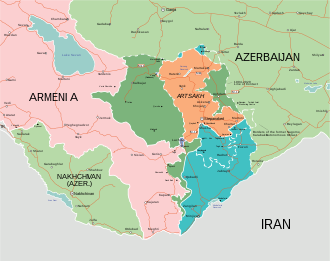This article needs to be updated. The reason given is: Events of the September 2023 offensive need to be added. (November 2023) |

In the aftermath of the Second Nagorno-Karabakh War, peacekeeping operations were initiated by Russia in the Nagorno-Karabakh region to monitor the ceasefire between the Armenian and Azerbaijani forces. Separate from the Russian operation, Turkey also has personnel working in a joint Russian–Turkish monitoring centre.
After the war, in accordance to the ceasefire agreement signed on 10 November 2020, Russia sent a peacekeeping contingent of 1,960 servicemen, provided by the 15th Separate Motor Rifle Brigade of the Russian Ground Forces, and led by Lieutenant General Rustam Muradov, to the region. The peacekeeping forces, headquartered near Stepanakert, established observation posts along the contact line in Nagorno-Karabakh and along the Lachin corridor. The Russian peacekeeping forces started to assist the International Committee of the Red Cross on finding and exchanging the bodies of the fallen soldiers from both sides in November, and the Russian peacekeepers later started demining operations in the region.
On 11 November, a memorandum of understanding was signed between Russia and Turkey to create a Russian-Turkish Joint Monitoring Centre (RTJMC) near Marzili in Aghdam, Azerbaijan. In December, Turkey sent 136 sappers to Azerbaijan to assist in the demining of the region, as well as to train mine clearance personnel of Azerbaijan. It also sent 35 of its officers to Azerbaijan. The RTJMC was opened on 30 January 2021, with a total of 60 servicemen from both sides monitoring the ceasefire using unmanned aerial vehicles. The Turkish staff of the RTJMC is headed by Major General Abdullah Katırcı, and the Russian staff is headed by Major General Victor Fedorenko, while the centre itself is guarded by the Azerbaijani servicemen.
The first major breach of the ceasefire that was confirmed by the Russian peacekeeping forces in the region occurred on 11 December, near Hadrut. Chaylaggala (Khtsaberd), Hin Tagher (Kohne Taghlar) villages, as well as the Katarovank monastery had become an Artsakh holdout in the Hadrut Province during the war. Clashes erupted around the Armenian holdout pocket despite the ceasefire agreement, and it has been reported that the Azerbaijani forces seized control of Hin Tagher on 12 December, with some clashes continuing in the area. Later, Artsakh authorities confirmed that six of their servicemen had been injured. Both sides accused each other of reigniting the conflict. The Russian peacekeeping forces requested both sides to respect the ceasefire. On 13 December, the Russian peacekeeping contingent took control of Hin Tagher. However, the next day, the Russian Ministry of Defence released a map showing both villages outside of the borders of the peacekeeping mission, and both came under Azerbaijan's control.
The blockade of Nagorno-Karabakh drew international criticism and raised doubts in the ability and willingness of the peacekeepers to fulfil their mission to ensure freedom and security of movement along the Lachin corridor in line with the trilateral ceasefire agreement of 9 November 2020.
In September 2023 Russian peacekeepers did not intervene as Azerbaijan launched a lightning offensive to seize the region, which resulted in mass exodus and near-complete emptying of its Armenian population.[1] In April 2024, Russian peacekeepers began to withdraw from Nagorno-Karabakh, leaving the region under the full control of Azerbaijan.[2][3]
- ^ "Russia rejects criticism of peacekeepers in Karabakh". eurasianet.org. Jan 15, 2024.
- ^ "Russia announces total withdrawal of troops from Nagorno-Karabakh". Politico. 17 April 2024. Retrieved 17 April 2024.
- ^ "Российские миротворцы покинули Азербайджан". caliber.az. April 16, 2024.